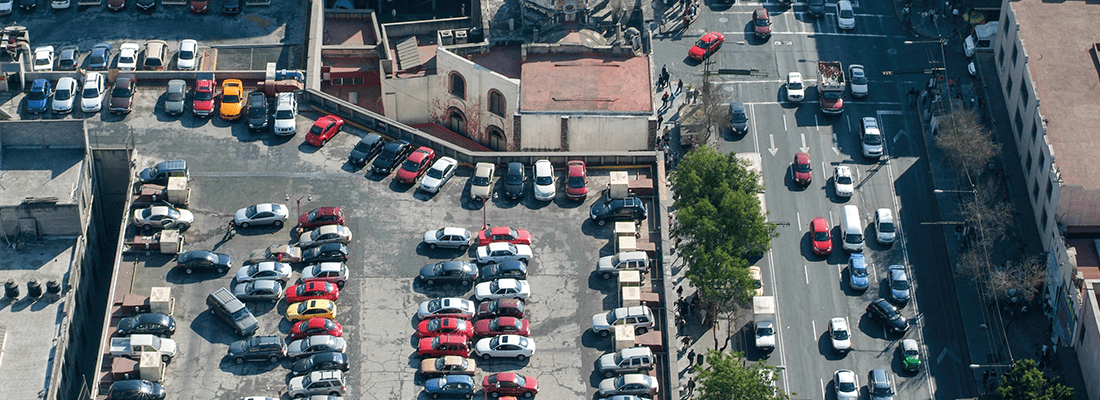Mexico City has too much traffic. Thanks to the partial success of environmental measures, including its low-tech Hoy No Circula emissions-reduction scheme, the largest metropolis in the western hemisphere is no longer ranked as the world’s most polluted city by the World Health Organization, as it was in 1992 – but, according to TomTom’s Congestion Index, it is now the most congested city on Earth, with journeys taking on average 66% longer than in free-flow conditions and traffic gridlock adding 227 frustrating hours of travel time to the annual life of a typical commuter.
Urban congestion tends to be compounded by drivers already at their destination circling in search of parking: one study by US parking guru Dr Donald Shoup found that people searching for parking along a 15-block section of Los Angeles burned 47,000 gallons of fuel annually, producing 730 tons of CO2 a year. Thus, Shoup’s proposed remedy – actually reducing the availability of parking spaces – appears counterintuitive at first, but is fast gaining credence. It has recently been adopted in Mexico City, where parking minimums – rules stipulating that builders provide a minimum number of spaces in proportion to a development’s size – have been replaced with parking maximums, limiting spaces provided.
“Most cities have required developers to build a certain amount of parking,” explains Rodrigo García Reséndiz, senior planner with Alta Planning + Design. “Someone decided one day that, for instance, a hospital must have two parking spots per bed – but based on what? Nobody knows. These regulations were copied around the world, but it’s pseudoscience. Experience and research have shown that parking minimums just make people drive more.”
Oversupply of parking not only incentivizes driving, but creates an urban sprawl punctuated by soulless acres of parking lots: an auto-centric environment, hostile to pedestrianism, privileging cars over people. Reserving so much prime city-center real-estate for parking exacerbates a lack of affordable housing, pricing out those on lower incomes. Parking minimums drive up the cost of building projects, with developers naturally transferring the expense to residents – many non-car owners – by charging more for housing, goods or services.
In 2014, the Institute for Transportation and Development Policy (ITDP) identified off-street parking as the fastest-growing land use in Mexico City from 2009-2014, based on analysis of 251 building projects. More than 250,000 new spaces were created and parking accounted for 42% of the total area of new development, compared with 32% for housing, 15% office space and 9% retail. Automobile-oriented developments flourished, with big-box retailers typically providing 22% more spots than the legal minimum in vast car lots, only nearing capacity at peak times and around Christmas. Overall, parking accounted for nearly 40% of the cost of building projects.
In response, then-mayor Miguel Ángel Mancera announced Mexico City’s off-street parking reforms in July 2017. “They divided buildings into different types – commercial, public services, housing – and parking maximums were set,” explains García Reséndiz, a Mexico City native now working on sustainable infrastructure in Los Angeles. “You’re allowed to provide no parking at all as a developer. If you want to provide over 50% of the maximum you must pay a charge, which goes into an infrastructure fund helping to pay for sustainable transportation improvements.”
If the new parking caps are to effectively promote alternatives to driving, then investment in alternative modes will be important, and García Reséndiz is optimistic. “Mexico City is doing great things with Bus Rapid Transit [BRT],” he says. “When BRT started in Reforma Avenue last year, it was a little controversial because of the decision to use double-decker buses, which hadn’t been used before. But BRT is happening, in contrast to US cities that don’t want to give any roadway exclusively to buses. The Mexico City subway is good; it has daily ridership of 5.5 million,” he adds. “But it needs some love – and some money for maintenance, in particular.”
On-street reform
While the 2017 reforms address surplus off-street parking, new on-street parking controls began in 2011 with the introduction of ecoParq, a scheme involving installation of 721 parking meters, operational from 8:00am to 8:00pm, in a small cluster of central neighborhoods.
ecoParq sought to replace the previously unregulated trade of unofficial parking attendants, or franeleros, extracting fees from motorists in return for guarding their car, with the implicit threat that the car might be damaged should they refuse to pay. Franeleros tended to compound congestion problems by encouraging double- or triple-parking, which obstructed traffic flow. “The franeleros didn’t care about the walkability of the streets,” remarks García Reséndiz. “They were parking cars on the sidewalks, impeding movement of pedestrians and people with wheelchairs. It was chaotic.
“The effectiveness of controlling on-street parking by installing meters and drawing parking spots on streets has been proved,” he continues. “We have seen parking available all the time in neighborhoods that have the ecoParq installations.”
Whereas Donald Shoup advocates the use of dynamic pricing to ensure around 15% of parking remains available at any given time, García Reséndiz suggests ecoParq has achieved comparable results by setting fixed prices around the right level. “The current technology is not suitable for dynamic pricing,” he says. “San Francisco is doing it right now; they have a sensor on every spot, and when a car stops on that spot, a main computer calculates how many spots are free and starts increasing the price, depending on availability. It’s feasible for Mexico City, but they’d probably need to change the machines to make it happen.”
ecoParq has courted controversy due to a contract allocating just 30% of meter revenues to public infrastructure projects, as against 70% profit to the private contractor. The incoming administration of the newly elected mayor, Claudia Sheinbaum, may seek to change this, especially if ecoParq is extended and new companies become involved.
At present, it only covers a tiny area of this sprawling megacity. “There are around 26,000 metered parking spots,” says García Reséndiz, “The idea, eventually, is to reach 100,000. The city’s population is about 9 million and the metropolitan area is around 22 million – so 26,000 spaces is nothing. But it opens up a way for people to participate in democratic and public processes, because the government is asking neighborhoods whether or not they want the scheme to happen, based on the proof of more convenient parking and also revenue.”
Public transit potential
Despite the appearance of addiction to private vehicles Mexico City’s congestion gives, a 2017 survey revealed that 70% of journeys around the metropolis are actually made by other modes of transportation. This statistic highlights the injustice whereby a non-driving majority subsidize the driving minority through costs passed on to them by developers obliged – until recently – to provide minimum parking. However, García Reséndiz also sees it as a cause for hope, underlining the existing popularity of sustainable modes such as walking, cycling and car pooling, giving the incoming city administration a positive basis on which to build a more equitable network.
He also hopes that removing parking minimums will create a less auto-centric climate and lead to more affordable housing in Mexico City. But is there any proof that swapping minimum for maximum parking requirements alone has a benign social effect over time?
Parking minimums around the world
García Reséndiz points to US cities, such as Boston and Seattle, which have adopted parking caps – but these changes are only recent; their long-term effects as yet are difficult to discern. Across the Atlantic, London took the radical step of replacing parking minimums with maximums across its entire metropolitan area in 2004, which led to an estimated 143,893 fewer parking spaces being supplied from 2004-2010 – 40% down on the number previous minimums would have required. However, it is difficult to argue that living in London has become more affordable since 2004, although other factors – in particular, a property bubble fueled by overseas wealth – have been at play there.
According to current theory, building excess parking in cities amounts to a misuse of prime real estate, which would be better used for housing people than for resting cars; if developers are required to provide less parking, it is hoped their reduced costs will translate into more affordable housing. But can developers be trusted to pass savings on, rather than merely building high-end properties and pocketing increased profits? “There used to be a rule to incentivize the building of social housing in Mexico City, known as Norma 26,” says García Reséndiz, “but it was suspended in 2013 because developers were just using the density bonus to build luxury housing. So far, there are no plans to renew it or re-enact it.”
Time will tell whether Mexico City’s parking reforms can inspire a change in the mindset of those making daily transportation choices – or whether affordable housing will organically begin to fill the space of parking spots without further intervention. But they represent a positive step that could pave the way for further progressive measures and is relevant to cities further north. “Los Angeles is experiencing a homelessness crisis,” reflects García Reséndiz, “with 55,000 people sleeping on the streets every night. We are thinking about how to make housing affordable. It’s partly by building less parking, particularly ground-level parking, which is super-expensive. In the end, transportation policy and housing policy should go hand-in-hand.”



